A Star Surprises Us, the Full Moon Follows Max Jupiter, and Sights Despite Moonlight!

This simulated image of Jupiter shows how it will appear at opposition on Thursday night, August 19, 2021, when the Great Red Spot and Io and its shadow will be transiting the planet, as shown here at 10:30 pm EDT. (From Stellarium)
Hello, August Stargazers!
Here are your Astronomy Skylights for the week of August 15th, 2021 by Chris Vaughan. Feel free to pass this along to your friends and send me your comments, questions, and suggested topics. You can also follow me on Twitter as @astrogeoguy! Unless otherwise noted, all times are expressed in Eastern Time. To subscribe to these emails please click this MailChimp link.
I can bring my Digital Starlab portable inflatable planetarium to your school or other daytime or evening event, or teach a session online. Contact me through AstroGeo.ca, and we’ll tour the Universe, or the Earth’s interior, together!
The moon will flood evening skies with light this week as it transitions from first quarter to full – but keep an eye out for Perseids Meteor Shower bright stragglers. I share some moon-friendly targets, and de-mystify a surprise nova outburst in Ophiuchus. Mercury will kiss Mars in a tough to see conjunction, but we can all enjoy bright Venus, Saturn, and Jupiter, which reaches opposition on Thursday. Read on for your Skylights!
Perseids Meteor Shower Tapers Off
The prolific and worldwide Perseids Meteor Shower reached its peak last Thursday, but you can keep an eye out for more “shooting stars” as the shower tapers off until August 26. I wrote lots about seeing Perseids last week here. You can watch a 1-hour, family-friendly Perseids session that I participated in last Thursday from the observatory on YouTube here.
The Moon
The moon will complete the first quarter of its journey around Earth (measuring from the last new moon) this morning (Sunday, August 15) at 11:19 am EDT or 15:19 Greenwich Mean Time. At first quarter, the moon’s 90 degree angle away from the sun produces a half-illuminated moon – on its eastern side. Since the first quarter moon always rises around mid-day and sets around midnight, it is visible all evening and also in the afternoon daytime sky.
The evenings surrounding first quarter are the best ones for seeing the lunar terrain when it is dramatically lit by low-angled sunlight, especially along the terminator, the pole-to-pole boundary between the lit and dark hemispheres. With no atmosphere to scatter sunlight, shadows cast from every crater rim, mountain peak, and hump are a deep black.
Tonight’s moon will shine with the constellation of Libra (the Scales) on its right (celestial west) and reddish Antares, the brightest star in Scorpius on its left (celestial east). Antares sits rather low in the sky for folks viewing it from mid-northern latitudes – so expect it to twinkle a lot because its light is traversing 3 or 4 times as much air as the stars high overhead. By the way, Antares’ name means “rival of Mars”, because it resembles that red planet. Watch for a little white star named Dschubba “the Forehead [of the Scorpion]” tucked between Antares and the moon.
As the moon glides about 12° farther from the sun each night, it will wax fuller and set later. On Monday evening, the gibbous (i.e., more than 50%-illuminated) moon will shine a few finger widths above Antares – but it will be sitting just inside the lower (southern) boundary of the big constellation Ophiuchus (the Serpent-Bearer). (There’s more news about Ophiuchus below.)
From Tuesday through Thursday, the bright moon will traverse the teapot-shaped stars of Sagittarius (the Archer), and then commence its monthly visit with the bright gas giant planets. On Thursday evening, the medium-bright yellowish dot sitting a fist’s diameter to the moon’s upper left (or 13° to the celestial ENE) will be Saturn! On Friday night, the moon will land below Saturn. On Saturday night, the almost-full moon will gleam below very bright, white Jupiter.

The August full moon will occur on Sunday morning at 8:02 am EDT or 12:02 GMT. This full moon, colloquially called the “Sturgeon Moon”, “Black Cherries Moon”, “Green Corn Moon”, and “Grain Moon”, always shines among or near the stars of Aquarius (the Water-Bearer) or Capricornus (the Sea-Goat). The indigenous Anishinaabe people of the Great Lakes region call this moon Manoominike-giizis, the Wild Rice Moon, or Miine Giizis, the Blueberry Moon. The Cree Nation of central USA and Canada call it Ohpahowipîsim, the Flying Up Moon. The Haudenosaunee (Iroquois) of Eastern North America use Seskéha, the Freshness Moon.
The moon becomes fully illuminated when it is opposite the sun in the sky, so full moons rise at sunset and set at sunrise. Since the full phase will officially occur on Sunday morning in the Americas, the moon will appear to be full on both Saturday night and Sunday night. But magnified views will reveal a thin strip of darkness along the moon’s western and eastern limbs on Saturday and Sunday night, respectively. Observers around China and southeast Asia will get to see this moon rise while it is precisely full.
The Planets
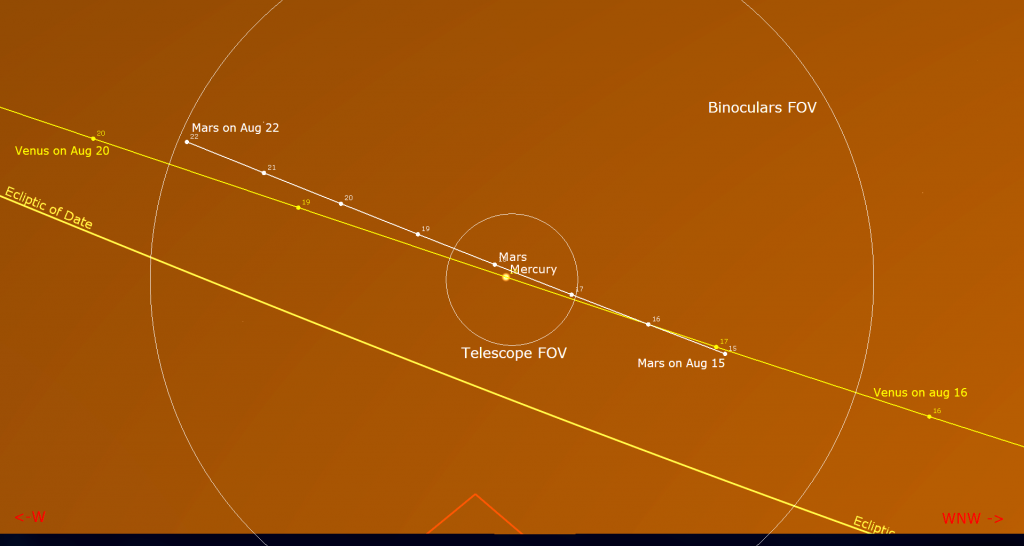
Magnitude -0.6 Mercury and ten times fainter Mars are huddled close to one another just above the western horizon after sunset this week. Speedy Mercury will pass so close to Mars on Wednesday that both planets will shine together in the eyepiece of a backyard telescope; although they’ll look pretty blurry while that low in the sky. Mars will be positioned to the upper left (8 arc-minutes to the celestial east) of Mercury, but your telescope will likely flip and/or mirror-image the scene. They will also be near one another on Tuesday and Thursday. You’ll need an unobstructed, cloud-free horizon to see them. (Don’t use optics until the sun has completely disappeared.) This conjunction will be tough to catch at mid-northerly latitudes; but observers at the latitude of the southern USA (and farther south) can see the pair in a darker sky just before they set (just before 9 pm local time).

Venus is the very bright and steady pinpoint of light shining partway up the western sky after sunset. A short time before 9 pm local time, the magnitude -3.9 planet will be poised a fist’s diameter above the western horizon (and earlier from more southerly locations) – then it will descend and set by 10 pm local time. You might need to stand where trees and buildings aren’t in your way. Venus is slowly moving farther from the sun – higher and leftward with each passing day. When viewed in a backyard telescope Venus will exhibit a smallish, featureless disk and a squashed shape because it’s only 77%-illuminated right now. Aim your telescope at Venus as soon as you can spot the planet in the sky (but ensure that the sun has completely disappeared first). That way, Venus will be higher and shining through less distorting atmosphere – giving you a clearer view.
At 9 pm local time, yellow-tinted Saturn sits about as high as Venus – but it’s way over in the southeastern sky. Saturn is already above the horizon at sunset, and then it spends the night riding the ecliptic until it sets in the southwest before dawn. Sixteen times brighter Jupiter, positioned about two fist diameters to the left (celestial east), is chasing Saturn this year.

Saturn’s axial tilt of 26.7° (a bit more than Earth’s 23.5° tilt) lets us see the top of its ring plane, and allows Saturn’s brighter moons to be distributed all around the planet. During this week, Saturn’s largest and brightest moon Titan will migrate counter-clockwise around Saturn, moving from the upper right (celestial northwest) of Saturn tonight to the right (celestial east) of the planet next Sunday. (Remember that your telescope will probably flip the view around.) How many moons can you see?
On Thursday, Jupiter will reach opposition among the stars of eastern Capricornus (the Sea-Goat). Since Earth will be positioned between the sun and the gas giant on that date, Jupiter will rise at sunset, remain visible all night long, and set at sunrise. At opposition, Jupiter will be 600.4 million km, or 33.3 light-minutes, from Earth, and it will shine at its maximum brightness of magnitude -2.88 for 2021. Because Jupiter will attain its minimum distance from the sun in January, 2023, the planet will sport an enlarged, 49 arc-seconds-wide disk at this year’s (and next year’s) opposition.
Binoculars and small telescopes will show you Jupiter’s four large Galilean moons named Io, Europa, Callisto, and Ganymede. Since Jupiter’s axial tilt is miniscule – only 3° – those moons are always strung like beads along a straight line that passes through the planet, parallel to Jupiter’s dark equatorial stripes. Their arrangement varies from night to night.
For observers in the Eastern Time Zone with good telescopes, the Great Red Spot (or GRS) will be visible crossing Jupiter on Monday, Thursday, and Saturday evening, late on Wednesday and Saturday night, and before dawn on Monday, Wednesday, and Saturday morning. From time to time, the small round black shadows cast by Jupiter’s Galilean moons become visible in amateur telescopes when they cross (or transit) the planet’s disk. Europa and its shadow will cross Jupiter with the Great Red Spot from 12:25 am to 3:25 am EDT on Thursday morning. On Thursday (opposition night), Io and its shadow will cross Jupiter from 9:50 pm to 12:05 am EDT. At 8:42 pm Central European Standard Time or 18:42 GMT on Sunday night, August 22, observers across Eastern Europe, eastern Africa, and Asia can watch Ganymede’s large shadow and Europa’s smaller shadow cross Jupiter together until 10:40 pm CEST or 20:40 GMT.
Dim, blue Neptune is located near the border between Aquarius and Pisces (the Fishes) – about two fist diameters to the left (or 25° to the celestial east) of Jupiter. Neptune rises at about 9:15 pm local time and reaches peak visibility halfway up the southern sky at 3 am local time. It will rise and peak about half an hour earlier each week.
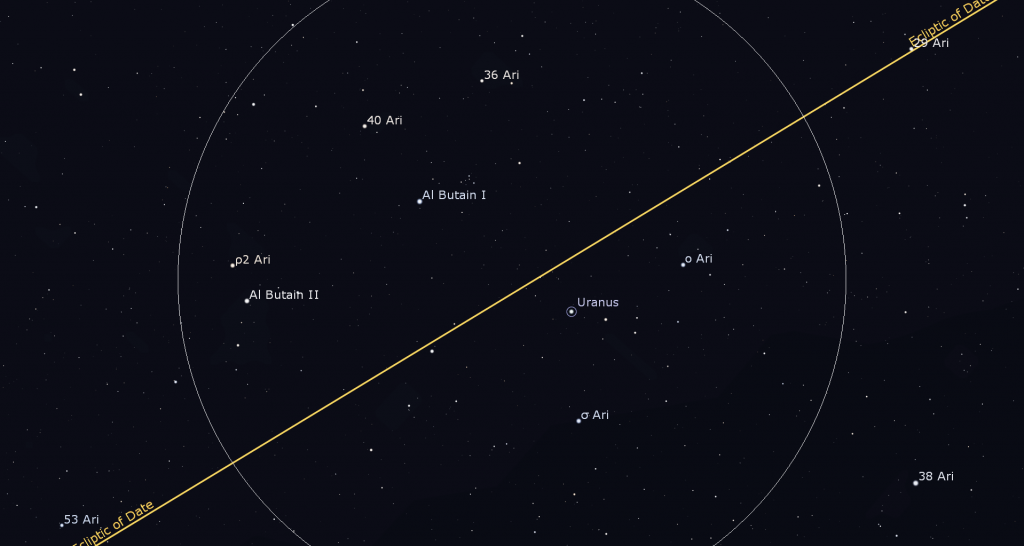
Magnitude 5.8 Uranus is bright enough to see with binoculars and backyard telescopes, even near cities. This week it will rise shortly after 11 pm local time. It will spend this year parked below Hamal and Sheratan, the two brightest stars in Aries (the Ram). On Friday, Uranus will cease its motion across the stars and prepare to commence a westward retrograde loop that will last until January, 2022. Uranus will be surrounded by the 5th magnitude (moderate brightness) stars Sigma, Omicron, Pi, and Rho Arietis – creating a distinctive asterism for anyone viewing Uranus in binoculars.
Sights for Moonlit Nights
While the moon will brighten evening skies all over the world this week, and ruin our views of summertime nebulas, the stars will still be able to entertain us.
The first stars to appear on mid-August evenings are the bright, white stars of the Summer Triangle. This asterism is an unofficial pattern formed using the brightest stars of three different constellations. (Anyone can make up their own asterism!) After dusk, the triangle is high in the eastern sky, just below the zenith. When you face east, Vega is at the top (closest to the zenith), dimmer Deneb sits two fist diameters to Vega’s lower left (or 23° to the celestial east). Altair sits three fist diameters to Vega’s lower right (or celestial south) – so the triangle is taller than wide. Despite its name, the asterism appears every summer and remains visible until the end of December!
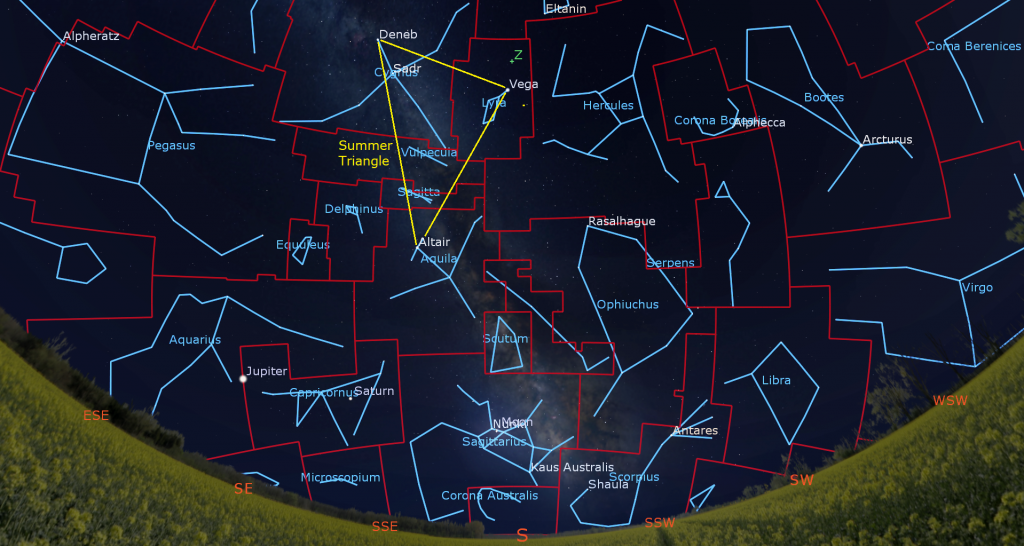
At magnitude 0.03, Vega is the brightest star in the summer sky, mainly due to its relative proximity to the sun of only 25 light-years. Altair is only 17 light-years from the sun, but Deneb is a staggering 2,600 light-years away. It’s so bright despite its greater distance because of its far greater inherent luminosity at visible wavelengths.
Stars shine with a colour that indicates their surface temperatures, and this is captured in their spectral classification. Our sun is a yellowish G-class star with a surface temperature of 5,800 K. The stars of the Summer Triangle are A-class stars that appear blue-white to the eye and have higher temperatures, in the range of 7,500 to 10,000 K.
The very bright and orange-tinted star Arcturus shines all evening long over in the western sky, in the kite-shaped constellation of Boötes (the Herdsman). Arcturus is a K-class giant star with a temperature of only 4,300 K. The Big Dipper stretches across the northwestern sky during evening. Its curved handle “arcs to Arcturus”. Arcturus’ name is derived from Arabic for “follower of the bear”, referring to Ursa Major (the Big Bear). Look closely at Mizar, the star where the dipper’s handle bends. A little star named Alcor is close to it. In a telescope, Mizar itself splits into a double star.
Reddish Antares, the heart of Scorpius (the Scorpion), which sits low in the south-southwestern sky, is an old M-class star with a surface temperature of 3,500 K. If you stay up past midnight, you’ll see bright yellowish Capella peeking over the northeastern horizon. It’s a sun-like G-class star located only 42 light-years away from us. By comparing these stars colours’ to other stars, you can estimate those stars’ temperatures. The classification letters, from hottest to coolest are: OBAFGKM. Can you think up a mnemonic phrase to remember the order? I’ll tell you mine when next we meet!
Here’s another trick to see star colours. Aim your telescope or binoculars at a star and unfocus the view so that the point-like star swells into a disk. You should be able to see that star’s colour better.
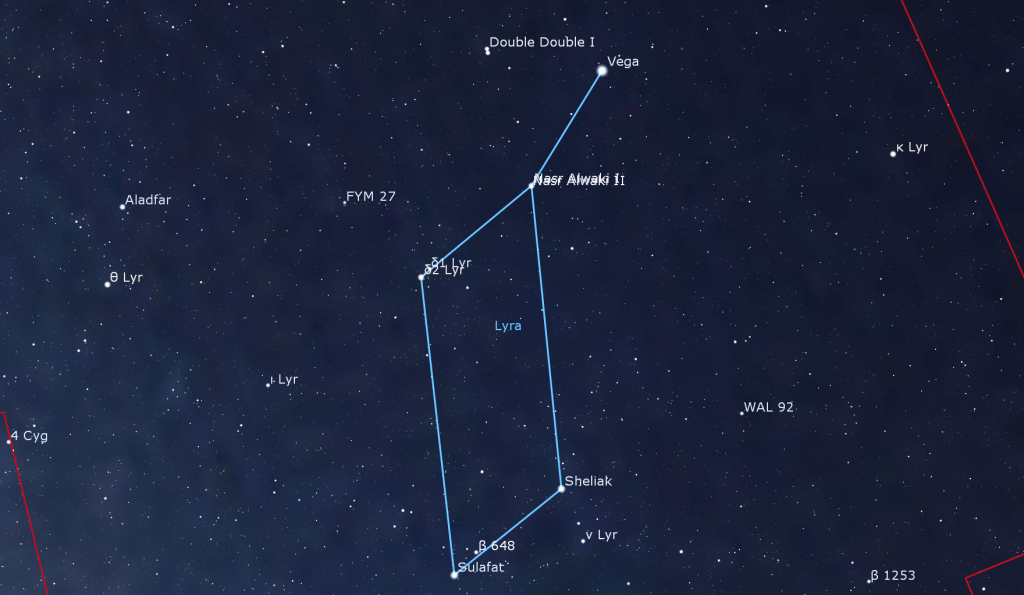
Vega’s home constellation of Lyra (the Harp) features a coffee and a donut! Keen eyes might reveal that the star Epsilon Lyrae, located just one finger’s width to the lower left (or celestial east) of Vega, is a double star. Binoculars or a small telescope will certainly show you two close-together stars. Examining Epsilon at even higher magnification will reveal that each of those stars is itself a double – hence its nick-name, “the double-double”. Epsilon Lyrae was given that name long ago, before astronomers could see its extra stars using telescopes. The quartet, plus a fainter fifth companion star, are bound together by their mutual gravity, and are slowly orbiting one another in a “cosmic square dance”!
To see the donut, aim your telescope midway between the stars Sulafat and Sheliak, which form the lower (southern) end of Lyra’s parallelogram. Messier 57, also known as the Ring Nebula, will appear as a faint grey ring. Higher magnification works well on this planetary nebula – which is the corpse of a star that had a similar mass to our sun.
A New Star – Sort of
On August 8, an amateur astronomer in Ireland named Keith Geary observed that a faint 11th magnitude red giant star named RS Ophiuchi had suddenly flared in brightness – to magnitude 5. That’s 400 times brighter! RS Oph (for short) has a habit of doing that – it’s a rare recurrent nova. Astronomers have recording about eight of its outbursts since 1898 – but it hadn’t flared since 2006.
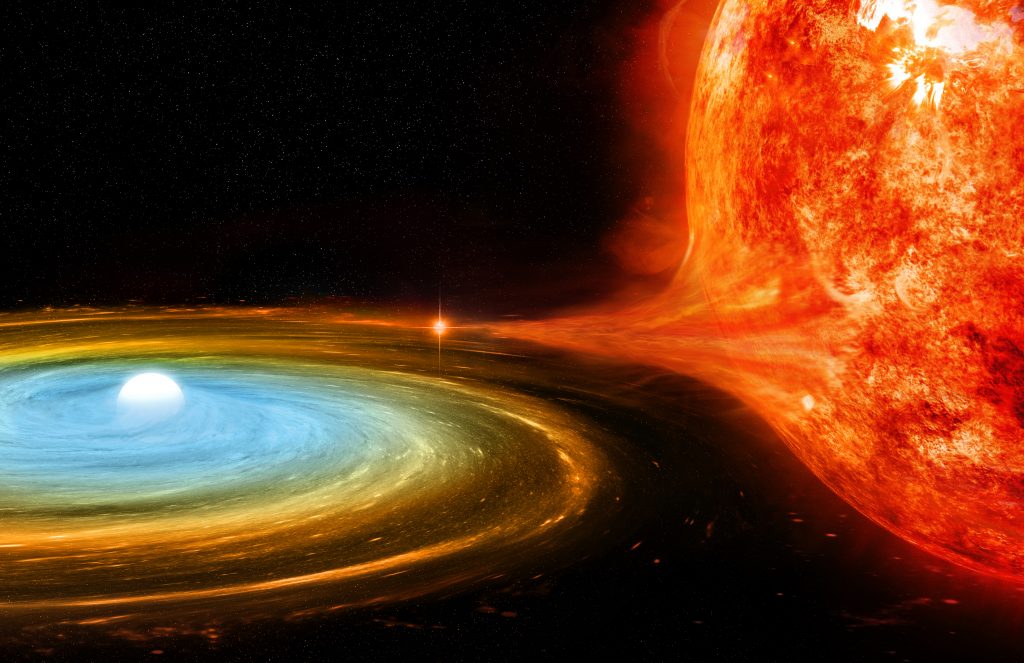
This type of nova occurs because the red giant star is orbited by a tiny white dwarf star, the core of a sun-sized star that blew off its outer layer when it died. The gravity from the white dwarf is sipping hydrogen from the red giant, which has swollen larger – so its outer layers are close enough to be attracted by the white dwarf. At some point, the accumulated hydrogen becomes enough to re-ignite fusion. But since that’s happening on the outside surface of the star, instead of inside the core where it would be under pressure, there’s nothing to contain the process – so it releases all of its energy at once, in a bright flash of light and radiation. Once released, the process re-starts.
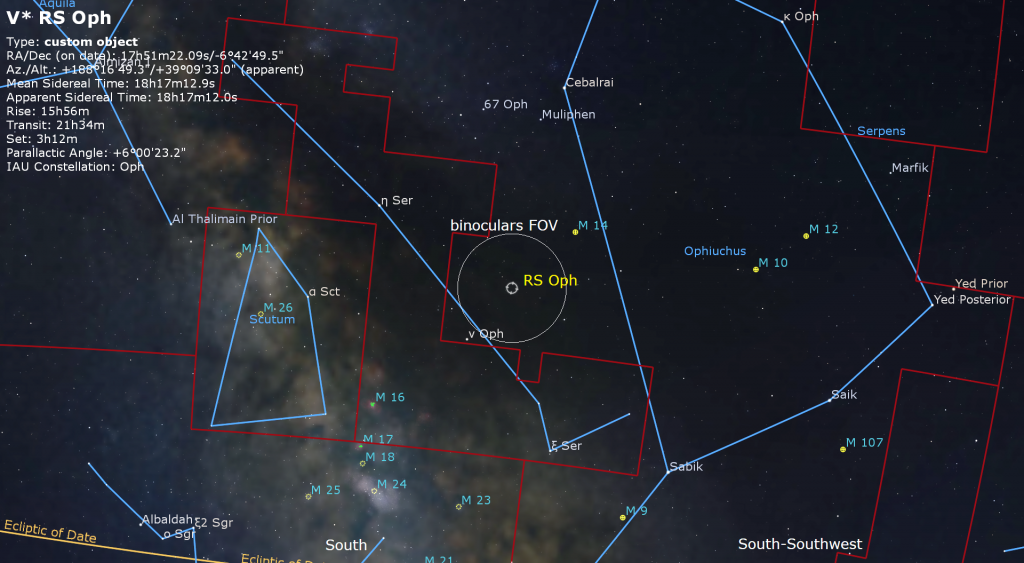
Although the star has faded in brightness by about half, it’s still well within reach of binoculars and backyard telescopes as a reddish orange star. From here on out, RS Oph will gradually fade in brightness, taking another six weeks to return to normal (and invisibility without a large telescope).
In mid-evening, Ophiuchus sits not quite halfway up the south-southwestern sky. RS Oph is located about midway between the very bright stars Antares and Altair, and a few finger widths to the upper right (or 3.75° to the celestial NNW) of the medium-bright star named v Ophiuchi. In the eyepiece it sits at the end of a little arc of dim stars. Catch a peek while you can. There’s a great article from Sky & Telescope here.

Public Astro-Themed Events
Every Monday evening, York University’s Allan I. Carswell Observatory runs an online star party – broadcasting views from four telescopes/cameras, answering viewer questions, and taking requests! Details are here. Their in-person Wednesday night viewing has been converted to online via the observatory YouTube channel.
Don’t forget to take advantage of the astronomy-themed YouTube videos posted by RASC Toronto Centre and RASC Canada.
My free, family-friendly Insider’s Guide to the Galaxy webcasts with Jenna Hinds of RASC National will return this Tuesday, August 17 with a Gas Giant Planets Special! We’ll talk about where and when to see Jupiter and Saturn (and Uranus and Neptune) with your unaided eyes, binoculars, or telescopes, interesting phenomena you can view, and observing tips. You can find more details and the schedule of future sessions here. Note: If you registered for the Zoom series last year, you will have received an email asking you to please re-register before Tuesday. (We’re cleaning out older unused registrations to make room for new viewers from libraries across Canada this fall.)
Public sessions at the David Dunlap Observatory may not be running at the moment, but we are pleased to offer some virtual experiences instead in partnership with Richmond Hill. The modest fee supports RASC’s education and public outreach efforts at DDO. Here are two upcoming events:
On Saturday night, August 20 from 9:30 to 11:00 pm EDT, the DDO Astronomy Speakers Night program will feature Dr. John E. Moores, York Research Chair in Space Exploration at York University. He’ll speak on The Cinematography of the Skies, how our robotic explorers study the changes on planets over time. There will also be a virtual tour of the DDO and live-streamed views from the DDO’s 74-Inch telescope (weather permitting). Only one registration per household is required. Deadline to register for this program is Wednesday August 18, 2021at 5 pm. The registration link is here.
On Sunday afternoon, August 22 from 12:30 to 1 pm EDT, join us for DDO Sunday Sungazing. Safely observe the sun with us, from the comfort of your home! During these family-friendly sessions, a DDO Astronomer will answer your questions about our closest star: the sun! Learn how the sun works and how it affects our home planet. Live-streamed views of the sun through small telescopes will be included, weather permitting. Only one registration per household is required. Deadline to register for this program is August 18, 2021 at 5 p.m. Prior to the start of the program you will be emailed information on the virtual program links and any specific information relating to your program. The registration link is here.
Space Station Flyovers
The ISS (or International Space Station) will not be visible gliding silently over the GTA until August 25, when it resumes pre-dawn passes. This week the Chinese Tiangong Space Station will make pre-dawn appearances over the GTA.
Keep looking up, and enjoy the sky when you do. I love questions and requests. Send me some!